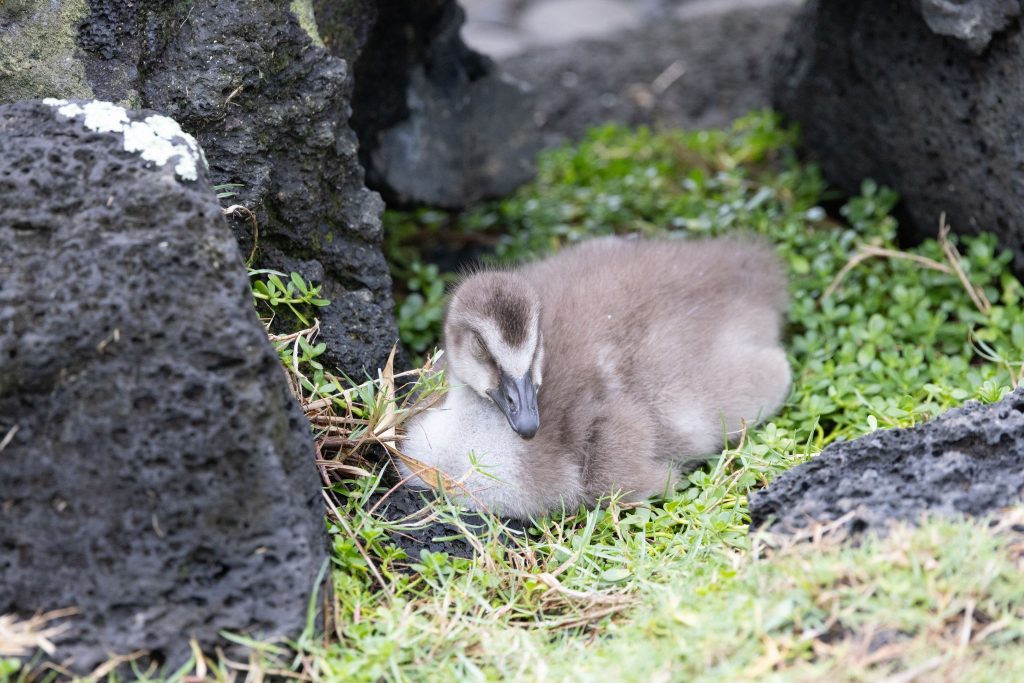4/23/24 – DEATH OF NĒNĒ GOSLING IN HILO PARK POINTS TO DISEASE CARRIED BY FERAL CATS
Posted on Apr 23, 2024 in Forestry & Wildlife, Main, News Releases, slider
| JOSH GREEN, M.D. GOVERNOR |
DAWN CHANG |
FOR IMMEDIATE RELEASE
April 23, 2024
DEATH OF NĒNĒ GOSLING IN HILO PARK POINTS TO DISEASE CARRIED BY FERAL CATS
Click on photo to view video
(HILO, HAWAI‘I ISLAND) – Toxoplasmosis, an infection spread only in the feces of feral cats, is likely what killed a nēnē gosling last month in Liliʻuokalani Park and Gardens.
The DLNR Division of Forestry and Wildlife (DOFAW) sent the diseased bird to the United States Geological Survey (USGS) National Wildlife Health Center for a necropsy (animal autopsy).
“This tragic incident highlights the problem of having feral cat colonies in areas that are known habitat for endangered or threatened species,” noted DLNR Chair Dawn Chang. “Toxoplasmosis, or ʻtoxo’ for short, according to the USGS, continues to be the chief cause of death for infectious diseases for nēnē and critically endangered Hawaiian monk seals. We must keep cats out of native wildlife habitats or we’re likely to see more deaths among Hawai‘i’s State Bird population,” Chang added.
Raymond McGuire, the DOFAW biologist who collected the gosling and sent it to the lab to determine cause of death, has studied and worked with nēnē for decades. He said nēnē have particularly strong familial bonds and there’s one thing about this gosling’s death that is especially sad.
The gosling’s mother, tagged as NTC, was the same bird that had another chick taken from her by a woman at another Hilo park in March, 2023. “We know cat lovers are animal lovers. We’re encouraging people who are feeding cats, sometimes in very large colonies, to consider the deadly consequences. We know, as animal lovers, their hearts are in the right place, but in addition to caring for wild cat populations please consider the tragic impacts imposed on two of the most iconic wildlife species in Hawai‘i, nēnē and monk seals. Open your hearts to them above non-native species like cats,” McGuire said.
Jordan Lerma, with the nonprofit Nēnē Research & Conservation added, “While it is well-known that a feral cat colony exists at Liliʻuokalani Park and Gardens, addressing this issue proves to be highly polarizing. In Hawaiʻi, attempts to manage feral cats often face strong animosity, making progress seem daunting. Our experiences with cat colony managers during the events at Queen’s Marketplace underscore these challenges. We hope to circumvent much of that backlash and focus on solutions that can benefit both conservation efforts and feral cats. We support legislation aimed at reducing pet abandonment, which includes requiring spaying/neutering for cats older than three months and mandatory microchipping. Additionally, we advocate to make it illegal to feed feral cats on Hawaiʻi County property to prevent the misconception that abandoned cats will be cared for.”
At Queen’s Marketplace in the Waikoloa resort last year, officers from the DLNR Division of Conservation and Resources Enforcement (DOCARE) ordered feral cat feeding to stop, at the request of the shopping center’s owners. Nēnē were eating cat food right alongside a large population of wandering cats.
The nonprofit Friends of Liliʻuokalani Gardens has put up signs cautioning visitors that it is illegal to touch, harass, feed, or harm a nēnē. “By feeding feral cats, people are clearly harming and killing nēnē, perhaps inadvertently, but the outcome is the same,” Chang commented.
# # #
RESOURCES
(All images/video courtesy or via: DLNR)
HD video – HD video – Nēnē family released (April 6, 2023):
Photographs – Nēnē NTC and 595 (from Nēnē Research & Conservation):
Media Contact:
Dan Dennison
Communications Director


